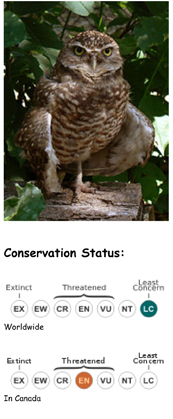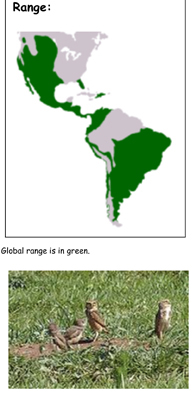Learn About Burrowing Owls
The Burrowing Owl (Athene cunicularia) is a small, long-legged owl found throughout open landscapes of North and South America.
The average adult is 25 cm (10 inches) in length, 53 cm (21 inches) wingspan, and is 170g (6 oz). They have bright yellow eyes. The beak can be between yellowish or greenish depending on the subspecies. The legs are incompletely feathered and grayish in color. They lack ear tufts and have a flattened facial disc. The owls have prominent white eyebrows and a white “chin” patch which they expand and display during certain behaviors. Adult owls have brown upperparts with white spotting. The breast and belly are white with variable brown spotting or barring.
The nesting season begins in late March or April in North America. Burrowing owls are usually monogamous, but occasionally a male will have two mates. They can be found in grasslands, rangelands, agricultural areas, deserts, or any other dry, open area with low vegetation. The owls nest in an underground burrow (such as those excavated by prairie dogs) hence the name Burrowing Owl.
The female will lay an egg every 1 or 2 days until she has completed a clutch that consists of usually 9 eggs. She will then incubate the eggs for three to four weeks while the male brings her food. After the eggs hatch, both parents will feed the chicks. Four weeks after hatching, the chicks are able to make short flights and begin leaving the nest burrow. The parents will still help feed the chicks for 1 to 3 months. While most of the eggs will hatch, only four to five chicks usually survive to leave the nest.
Unlike most owls, burrowing owls are often active during the day, although they tend to avoid the mid-day heat. Most hunting is still done from dusk until dawn. When hunting, they wait on a perch until they spot prey. Then, they swoop down on their prey or fly up to catch insects in flight. Sometimes, they chase their prey on foot across the ground. They mainly eat large insects and small rodents.
Although the Burrowing owl is listed as Least Concern on the IUCN Red List, it is endangered in Canada, threatened in Mexico, and a species of special concern in Florida and most of the western USA. It is common and widespread in open regions of many Neotropical countries, where they sometimes even inhabit fields and parks in cities. In regions bordering the Amazon Rainforest they are spreading with deforestation. Burrowing owls are protected under the Migratory Bird Treaty Act in Canada, the United States, and Mexico. They are also included in CITES Appendix II.
The major reasons for declining populations in North America are control programs for prairie dogs and loss of habitat.

Scientific Classification:
- Kingdom: Animalia
- Phylum: Chordata
- Class: Aves
- Subclass: Neornithes
- Infraclass: Neognathae
- Superorder: Neoaves
- Order: Strigiformes
- Family: Strigidae
- Genus: Athene
- Species: A. cunicularia

References: * Basto, Natalia; Rodríguez, Oscar A.; Marinkelle, Cornelis J.; Gutierrez, Rafael & Matta, Nubia Estela (2006): Haematozoa in birds from la Macarena National Natural Park (Colombia). Caldasia 28(2): 371-377 * BirdLife International (BLI) (2008). Athene cunicularia. 2008 IUCN Red List of Threatened Species. IUCN 2008. Retrieved on 29 December 2008. * Brattstrom, Bayard H. & Howell, Thomas R. (1956): The Birds of the Revilla Gigedo Islands, Mexico. Condor 58(2): 107-120. * Clark, H.O. Jr. & Plumpton, D.L. (2005): A simple one-way door design for passive relocation of Western Burrowing Owls. California Fish and Game 91: 286-289. * DeSante, D.F.; Ruhlen, E.D. & Rosenberg, D.K. (2004): Density and abundance of burrowing owls in the agricultural matrix of the Imperial Valley, California. Studies in Avian Biology 27: 116-119. * Environment Canada (2006): Species at Risk – Burrowing Owl. Version of 2006-MAY-08. Retrieved 2007-AUG-16. * Haug, E.A.; Milsap, B.A. & Martell, M.S. (1993): Burrowing owl (Speotyto cunicularia). In: Poole, A. & Gill, F. (eds.): The Birds of North America 61. Academy of Natural Sciences, Philadelphia, PA & American Ornithologists’ Union, Washington, D.C. Online version, retrieved 2006-DEC-26. * Holt, D.W.; Berkley, R.; Deppe, C.; Enríquez Rocha, P.L.; Petersen, J.L.; Rangel Salazar, J.L.; Segars, K.P. & Wood, K.L. (1999): 155. Burrowing Owl. In: del Hoyo, J.; Elliott, A.; and Sargatal, J. (eds.) (1999): Handbook of the Birds of the World (Volume 5: Barn-owls to Hummingbirds): 227-228, plate 17. Lynx Edicions, Barcelona. * Konig, C.; Weick, F. & Becking, J.-H. (1999): Owls: A guide to the owls of the world. Yale University Press, New Haven. * Klute, D.S.; Ayers, L.W.; Green, M.T.; Howe, W.H.; Jones, S.L.; Shaffer, J.A.; Sheffield, S.R. & Zimmerman, T.S. (2003): Status assessment and conservation plan for the western burrowing owl in the United States. Fish and Wildlife Service Biological Technical Publication FWS/BTP-R6001-2003. US Dept of Interior, Washington, D.C. * Korfanta, N.M.; McDonald, D.B. & Glenn, T.C. (2005): Burrowing owl (Athene cunicularia) population genetics: A comparison of North American forms and migratory habits. Auk 122(2): 464-478. * Levey, D.J.; Duncan, R.S. & Levins, C.F. (2004): Use of dung as a tool by burrowing owls. Nature 431(7004): 39. * Lewis, D.P. (2005): Burrowing Owl – Athene cunicularia. OwlPages.com Owl Species ID: 220.040.000. Version of 2005-APR-24; retrieved 2006-DEC-26. * Lutz, R.S. & Plumpton, D.L. (1999): Philopatry and nest site reuse by burrowing owls: implications for productivity. Journal of Raptor Research 33: 149-153. * Motta-Junior, José Carlos (2006): Relações tróficas entre cinco Strigiformes simpátricas na região central do Estado de São Paulo, Brasil [Comparative trophic ecology of five sympatric Strigiformes in central State of São Paulo, south-east Brazil]. Revista Brasileira de Ornitologia 14(4): 359-377 * Moulton, C.E.; Brady, R.S. & Belthoff, J.R. (2005): A comparison of breeding season food habits of burrowing owls nesting in agricultural and nonagricultural habitat in Idaho. Journal of Raptor Research 39: 429-438. * OwlPages.com (2005): 220.040.000 Burrowing Owl – Athene cunicularia. Version of 2005-ARP-24. Retrieved 2008-DEC-29. * Trulio, Lynne A. (1995): Passive relocation: A method to preserve burrowing owls on disturbed sites. Journal of Field Ornithology 66(11): 99-106.

